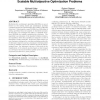Free Online Productivity Tools
i2Speak
i2Symbol
i2OCR
iTex2Img
iWeb2Print
iWeb2Shot
i2Type
iPdf2Split
iPdf2Merge
i2Bopomofo
i2Arabic
i2Style
i2Image
i2PDF
iLatex2Rtf
Sci2ools
GECCO
2007
Springer
2007
Springer
An analysis of the effects of population structure on scalable multiobjective optimization problems
Multiobjective evolutionary algorithms (MOEA) are an effective tool for solving search and optimization problems containing several incommensurable and possibly conflicting objectives. Unfortunately, many MOEAs face difficulties in solving problems when the number of objectives increases. In this paper, we investigate the efficacy of spatially structured MOEAs for scalable multiobjective problems. The algorithm is an extension of the standard cellular evolutionary algorithm, where the population is mapped to nodes of alternative complex networks. A selection regime based on a non-dominance rating and a crowding mechanism guides the evolutionary trajectory and an -dominance external archive is used to maintain a spread of solutions across the Paretooptimal front. An important outcome of this work is the classification of the network models based on their impact on convergence speed and solution quality as the number of objectives increases for a given problem. Categories and Subject ...
Evolutionary Algorithm | GECCO 2007 | Multiobjective Evolutionary Algorithms | Objectives Increases |
Related Content
| Added | 07 Jun 2010 |
| Updated | 07 Jun 2010 |
| Type | Conference |
| Year | 2007 |
| Where | GECCO |
| Authors | Michael Kirley, Robert L. Stewart |
Comments (0)

